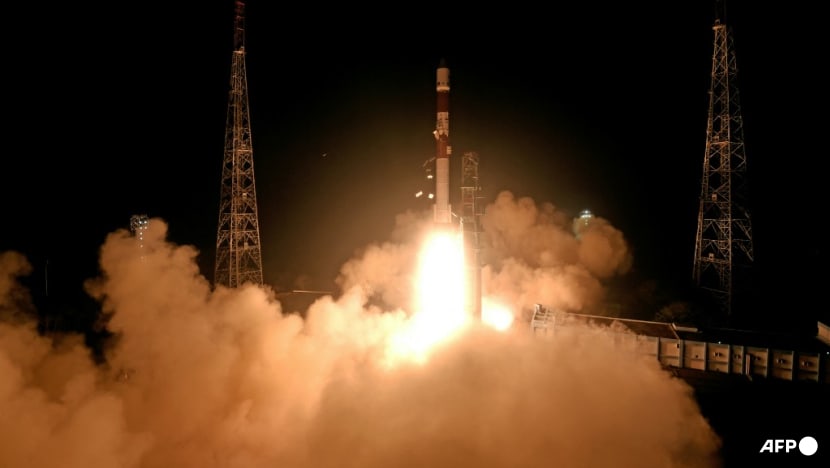Commentary: India is hitting the gas on building up its space capabilities. Here's why
The year 2025 began on a high note for India's space programme, but the accelerated progress of its space capabilities is about more than cool tech, says OP Jindal Global University's Dr Gunjan Singh.

The launch of the ISRO PSLV-C60 rocket carrying two SpaDeX satellites SDX01 (Chaser) and SDX02 (Target) from the Satish Dhawan Space Centre in Sriharikota on Dec 30, 2024. (File photo: AFP/Indian Space Research Organisation/Handout)

This audio is generated by an AI tool.
DELHI: The year 2025 began on a high note for the Indian space programme.
India in January undertook its 100th space launch by propelling a navigation satellite to geostationary orbit and also successfully conducted a space docking mission (Space Docking Experiment, SpaDeX). This makes India only the fourth country to achieve this feat of joining together two crafts in space, after the United States, Russia and China.
The success of the docking mission is crucial for New Delhi’s space ambitions and future plans.
India plans to launch a manned mission to the moon by 2040, send an orbiter to Venus, and start work on its first space station. The Indian Space Research Organisation (ISRO) is also expected to launch Chandrayaan-4 in 2027 with the aim of bringing back samples of moon surface. In 2023, India became the fourth nation to land an unmanned mission to the moon.
The Indian space programme, which is primarily a civilian programme, started formally with the ISRO’s establishment in 1969.
While its achievements so far are remarkable as an example of what a country can achieve in a small time frame, it’s also a feat of economy: New Delhi has managed this on a meagre budget of US$1.6 billion. In comparison, the United States’ National Aeronautics and Space Administration (NASA) has an annual budget of around US$25 billion.
In fact, most of India’s space missions have cost less than the average Hollywood blockbuster - the Chandrayaan-3 cost around US$75 million while Mars orbiter Mangalyaan cost around US$74 million.
India is proof that even with a relatively small budget, it’s possible to have a successful and profitable space programme. Indian scientists assert that this is also due to the international sanctions imposed on New Delhi following India’s first nuclear test in 1974, forcing them to develop homegrown technologies rather than shell out for expensive imports.
India has become one of the leading space-faring nations, at a time when the superpower space race is heating up. Can India’s space sector take off, or will it be a failure to launch?
WHY SPACE?
Why is having a space presence still such an attractive prospect for so many countries today?
One major aspect is the utility of space technologies for ground operations of military forces.
In the last few decades, the interconnectedness of space technologies, especially in the form of navigation and reconnaissance satellites, have become indispensable. The satellites can help in planning and facilitating troop movements, as well as providing real-time data of the topography and other challenges.
For India, given its ongoing border conflict with China and adversarial relations with Pakistan, it’s imperative to have better eyes in the sky. New Delhi needs to stay on top of Chinese troop movements and border constructions undertaken by Beijing, as well as other infrastructure growth across the border.
A functional space programme can also be greatly beneficial for civilian and economic growth and improving living standards.
Former ISRO chief S Somanath in August 2024 stated that the Indian’s space programme’s economic impact has been 2.5 times the investment, creating not only jobs and employment opportunities but also support systems for fishermen, agriculture, crop forecasting, natural resource planning and disaster avoidance.
This, coupled with increased capabilities for improving day-to-day navigation, internet, streaming, connectivity all widen India’s range for stronger economic growth - and not just in the domestic sense.
Success in space also provides the opportunity to benefit from the growing commercialisation of this global industry, which McKinsey estimates will be worth US$1.8 trillion by 2035. Dr Somanath expects the size of India's space economy to swell from US$9 billion currently to US$45 billion in the next 10 years, with the private sector playing a “major role”.
Having a proven track record of credible space capabilities, particularly in launching, can give a country big leg up in this burgeoning sector. A number of countries launch satellites for other countries as well as share navigational and other data.
IMPLICATIONS FOR INDIA-CHINA RELATIONS
India’s space aspirations, though currently rooted in civilian aspects, have attracted a lot of international attention. Unsurprisingly, India’s space programme has often been compared to that of China’s - though one should not overlook the fact that the latter is military-based.
Beijing is way ahead in navigation, its own network BeiDou boasting a better and larger range compared to India’s NavIC. China also has a functioning space station and has demonstrated space technologies like space-walk, docking, as well as an anti-satellite test.
China’s Long March is also one of the most successful launching platforms in the world today, and Beijing has plans to launch around 100 satellites by 2025.
Both India and China are developing their capabilities and have a lot riding on their space programmes, showing great nationalistic euphoria with each new achievement. However, the political discontent and conflict between the two parties have also been reflected in the space domain.
Both nations have shown no inclination to collaborate or cooperate for mutual gain. In the last few years, New Delhi seems to be leaning more towards cooperation with the US and NASA.
Given that 2011’s Wolf Amendment makes it impossible for Beijing to cooperate with the US, this further reduces the likelihood that India and China will work together for any space-related pursuits, even if they were able to put aside long-standing issues of mistrust.
Space will be a very important domain of India-China relations in the coming years, as well as in global geopolitics as the new currency of both hard and soft power. As India continues to reach new heights with its space programme, it would do well to ensure that the country becomes not just a significant space power, but a responsible one.
In addition, it should get engaged in the making of rules and policies which will govern this domain, and make sure that the voice of upcoming space-capable countries like itself is adequately heard.
Dr Gunjan Singh is an associate professor at the Jindal Global Law School, OP Jindal Global University, in India. She teaches international relations and China studies.

















